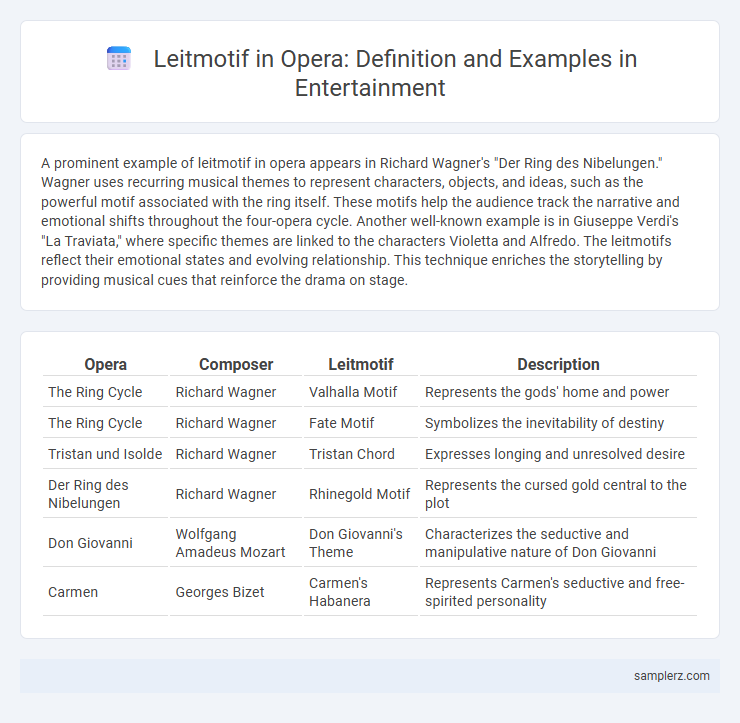A prominent example of leitmotif in opera appears in Richard Wagner's "Der Ring des Nibelungen." Wagner uses recurring musical themes to represent characters, objects, and ideas, such as the powerful motif associated with the ring itself. These motifs help the audience track the narrative and emotional shifts throughout the four-opera cycle. Another well-known example is in Giuseppe Verdi's "La Traviata," where specific themes are linked to the characters Violetta and Alfredo. The leitmotifs reflect their emotional states and evolving relationship. This technique enriches the storytelling by providing musical cues that reinforce the drama on stage.
Table of Comparison
| Opera | Composer | Leitmotif | Description |
|---|---|---|---|
| The Ring Cycle | Richard Wagner | Valhalla Motif | Represents the gods' home and power |
| The Ring Cycle | Richard Wagner | Fate Motif | Symbolizes the inevitability of destiny |
| Tristan und Isolde | Richard Wagner | Tristan Chord | Expresses longing and unresolved desire |
| Der Ring des Nibelungen | Richard Wagner | Rhinegold Motif | Represents the cursed gold central to the plot |
| Don Giovanni | Wolfgang Amadeus Mozart | Don Giovanni's Theme | Characterizes the seductive and manipulative nature of Don Giovanni |
| Carmen | Georges Bizet | Carmen's Habanera | Represents Carmen's seductive and free-spirited personality |
Defining Leitmotif in Opera
A leitmotif in opera is a recurring musical theme associated with a particular character, idea, or emotion, serving as an aural symbol that enhances storytelling and emotional depth. Richard Wagner's operas, such as "The Ring Cycle," famously utilize leitmotifs to represent gods, heroes, and mystical objects, creating an intricate musical narrative. This technique enables audiences to recognize and interpret characters or themes through repeated melodic patterns, intensifying the operatic experience.
Wagner’s Signature Leitmotifs in The Ring Cycle
Wagner's Ring Cycle features powerful leitmotifs such as the "Valhalla" theme, symbolizing the gods' majestic fortress, and the "Curse" motif, representing the destructive power of the ring. These recurring musical phrases create deep emotional connections and narrative cohesion throughout the four operas: Das Rheingold, Die Walkure, Siegfried, and Gotterdammerung. Wagner's innovative use of leitmotifs revolutionized opera by blending music and storytelling into a continuous dramatic experience.
Leitmotifs in Verdi’s Otello
Leitmotifs in Verdi's Otello illustrate the opera's intense psychological drama through recurring musical themes associated with characters and emotions. The dark, brooding motif representing Iago signals deceit and malevolence whenever it appears, enhancing narrative tension. Otello's heroism and eventual downfall are underscored by a noble, yet tragic leitmotif that evolves throughout the opera.
Puccini’s Use of Leitmotif in Tosca
Puccini's opera Tosca masterfully employs leitmotifs to deepen character development and enhance dramatic tension, such as the anguished motif associated with Tosca herself and the sinister theme representing Scarpia's menace. These recurring musical phrases not only underscore the psychological states and relationships of the characters but also provide cohesion across the opera's three acts. The strategic use of leitmotifs in Tosca exemplifies Puccini's skill in integrating thematic material to evoke emotional resonance and narrative complexity.
Leitmotif in Bizet’s Carmen
Leitmotifs in Bizet's Carmen vividly illustrate character and emotion, with the famous habanera theme symbolizing Carmen's seductive and free-spirited nature. The Toreador Song serves as a bold leitmotif representing Escamillo's confident and heroic persona. These recurring musical phrases enhance narrative depth and audience connection throughout the opera.
The Evolution of Leitmotif in Modern Opera
Wagner's use of leitmotifs in operas like "The Ring Cycle" laid the foundation for thematic development in modern opera, where recurring musical phrases represent characters, emotions, or ideas. Contemporary composers such as Philip Glass and John Adams have evolved leitmotifs by incorporating minimalist and postmodern techniques to create complex narrative layers. This evolution allows modern operas to convey psychological depth and intricate storytelling through sophisticated thematic motifs.
Leitmotif and Character Development
In Wagner's opera "The Ring Cycle," the use of leitmotifs intricately weaves musical themes to represent characters, emotions, and objects, enhancing character development by providing deeper psychological insight and narrative continuity. Each leitmotif evolves in complexity and orchestration, mirroring the transformation and growth of characters like Siegfried and Brunnhilde throughout the opera. This technique allows audiences to subconsciously connect musical signatures with character arcs, enriching the storytelling experience.
Musical Themes as Storytelling Tools
In opera, leitmotifs function as recurring musical themes that represent characters, emotions, or ideas, enhancing narrative depth. Richard Wagner's "Der Ring des Nibelungen" exemplifies this technique, using distinct leitmotifs to guide audiences through complex storylines and character developments. These motifs enable a multilayered storytelling experience by musically encoding plot elements and psychological states.
Leitmotif’s Emotional Impact on Audiences
The use of leitmotifs in opera significantly enhances emotional engagement by consistently associating specific musical themes with characters, emotions, or ideas, deepening audience connection to the narrative. Wagner's Ring Cycle exemplifies this technique, where recurring motifs evoke complex feelings such as love, fate, and betrayal, creating a powerful, immersive experience. These thematic patterns elicit subconscious recognition, heightening emotional resonance and making operatic storytelling more compelling and memorable.
Notable Leitmotif Examples in 21st Century Opera
Notable leitmotif examples in 21st-century opera include Thomas Ades' "The Tempest," where distinct musical themes represent characters like Prospero and Ariel, enhancing emotional depth and narrative structure. In Kaija Saariaho's "L'Amour de Loin," recurring melodic motifs evoke themes of longing and distance, creating an immersive sonic atmosphere. These leitmotifs serve as powerful tools for thematic development and character identification within contemporary operatic storytelling.

example of leitmotif in opera Infographic
 samplerz.com
samplerz.com